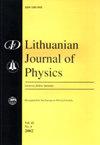在基于半导体的太赫兹探测器芯片上使用石蜡进行超基底透镜集成
IF 0.3
4区 物理与天体物理
Q4 PHYSICS, MULTIDISCIPLINARY
引用次数: 0
摘要
如果电磁辐射探测器的传感器面积较小,则可以使用基片透镜,将辐射聚焦到设备的有效传感区域,从而提高其响应速度。为了避免反射损失,使用这种直接安装在探测器背面的透镜要求探测器的基板和背面对辐射是透明的。然而,如果情况并非如此,我们可以在探测器的正面安装一个叠层透镜。如果探测器需要用两束光照射,例如用于外差探测,其中一束光提供本振信号,那么同时使用基底透镜和叠层透镜可能更有意义。然而,由于探测器表面形貌不平整或前侧存在粘合线,使用叠层透镜往往会受到阻碍或妨碍。在此,我们将解决这一问题,并探索使用石蜡来形成或附着叠层透镜。在第一种情况下,也就是本文的主要议题,我们利用液态石蜡的表面张力,将其带到探测器上,将石蜡本身雕刻成透镜。在第二种情况下,我们使用石蜡形成一层薄薄的中间层,这层中间层也是粘合塑料或硅透镜的粘合剂。在这两种情况下,使用液态石蜡都可以填充不平整的探测器表面,并在不破坏导线的情况下嵌入导线。我们研究了将蜡用于 CMOS TeraFET(基于场效应晶体管的太赫兹辐射探测器)嵌入天线结构的情况。我们描述了加工步骤,并分析了配备这种蜡叠层透镜的 TeraFET 的性能,该透镜用于前侧光束耦合。本文章由计算机程序翻译,如有差异,请以英文原文为准。
Superstrate-lens integration using paraffin wax on top of semiconductor-based THz detector chips
A detector of electromagnetic radiation may benefit – if its sensor area is small – from the application of a substrate lens, which focusses the radiation onto the active sensing area of the device and thus enhances its responsivity. The use of such a lens, attached directly onto the detector backside in order to avoid reflection losses, requires that the detector substrate and backside be transparent to the radiation. However, if this is not the case, one may like to place instead a superstrate lens onto the front side of the detector. It may even be of interest to use both a substrate and a superstrate lens if the detector needs to be illuminated with two beams, e.g. for heterodyne detection, where one beam provides the local-oscillator signal. The use of a superstrate lens is, however, often hindered or impeded by an uneven surface topography or by the presence of bonding wires on the front side of the detector. Here, we address this issue and explore the use of paraffin wax to form or attach superstrate lenses. In the first case, which is the main topic of this contribution, we exploit the surface tension of liquid paraffin, brought onto the detector, to sculpt the wax itself into a lens. In the second case, only addressed conceptually here, we use paraffin to form a thin intermediate layer which also acts as an adhesive for the attachment of a plastic or silicon lens. In both cases, the application of liquid paraffin allows one to fill out an uneven detector surface and to embed wires without breaking them. We investigate the use of wax for the case of CMOS TeraFETs – detectors of terahertz radiation based on field-effect transistors – embedded into antenna structures. We describe the processing steps and analyze the performance of a TeraFET equipped with such a wax superstrate lens for front-side beam coupling.
求助全文
通过发布文献求助,成功后即可免费获取论文全文。
去求助
来源期刊

Lithuanian Journal of Physics
物理-物理:综合
CiteScore
0.90
自引率
16.70%
发文量
21
审稿时长
>12 weeks
期刊介绍:
The main aim of the Lithuanian Journal of Physics is to reflect the most recent advances in various fields of theoretical, experimental, and applied physics, including: mathematical and computational physics; subatomic physics; atoms and molecules; chemical physics; electrodynamics and wave processes; nonlinear and coherent optics; spectroscopy.
 求助内容:
求助内容: 应助结果提醒方式:
应助结果提醒方式:


